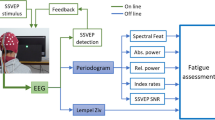Abstract
We studied the direct and aftereffects of twofold hyperventilation (HV) on pattern reversing VEPs and pupillograms (PGs) of 19 healthy volunteers. The VEP-N80 and P100 latencies increased during HV. Both peak times were maintained for a longer period, up to 20 minutes after HV-2 ended. In addition, the PG-latency time during HV and the PG-construction time during and after HV were increased. The results indicated a temporary delay of neural afferent transmission in the visual system during and after HV. A similar delay of the nervous transmission appeared in the efferent part of the system regulating the pupillary movements after HV ended. The observed changes of the VEP and PG parameters most probably resulted from the hypocapnia cased by HV and its effect on the brain vessels, although other explanations for the changes of the VEP- and PG-parameters may have been possible.
Similar content being viewed by others
References
Dodt E. Elektrophysiologische Topodiagnostik visueller Störungen. Ergebn exper Med 1982; 41: 299–306.
Ivanitzkij AM. Brain mechanisms for signal estimation. Moskow: Medicine, 1976 (Russ.).
Shagass C. Evoked brain potentials in psychiatry. Moskow: Mir, 1975.
Gavriysky V. Visually evoked potentials and physical loading. Questions of the Physical Culture 1976; 4: 223–8 (Bulg.).
Zenkov LR, Losev NI, Melnichuck VP, Radzevich TE. Changes of the VEP-amplitude by hyprventilation at healthy and epileptic humans. Human physiology 1976; 2: 208–14 (Russ.).
Drischel H. Untersuchungen über die Dynamik des Lichtreflexes der menschlichen Pupille. I und II Mitteilung Pflüg Arch 1957; 264: 145–190.
Drischel H. Neues über die Pupille. Sitzungsber. Sächs Akad der Wissensch Leipzig (Akad Verlag, Berlin) 1983; 116/5: 1–30.
Löwenstein O., Loewenfeld I. The Pupil. In: Davson H, ed. The eye. New York-London: Academic Press, 1969: 255–337.
Albrecht H, Bruhn R, Lorenz D, Lücker PW, Schumacher M. Pupillometrie: Eine nicht-invasive pharmakokinetische und pharmakodynamische Untersuchungsmethode zur Wirkung von Trospiumchlorid (Spasmo-lyt®) an der glatten Muskulatur. Meth Find Exper Clin Pharmacol 1983; 5(8): 585–7.
Grünberger J, Linzmayer L, Cepko H, Saletu B. Pupillometrie im psychopharmakologischen Experiments. Arzneimittel-Forschung/Drug Res 1986; 36(1): 141–6.
Loewenfeld I. Supra-spinale Hemmung. Mechanismus und geschichtliche Entwicklung. In: Die normale und die gestörte Pupillenbewegungen, Symp der DOG, 1972. München: Bergmann Verlag, 1973: 115–45.
Appenzeller O. The normal pupil and some pupillary abnormalities. In: Appenzeller O. The Autonomic Nervous System. Amsterdam-Oxford-New York: North-Holland Publ. 1976: 223–6.
Ohtsuka K, Asakura K, Kawasaki H, Sawa M. Respiratory fluctuations of the human pupil. Exper Brain Res 1988; 71: 215–7.
Alexandridis E. Pupillographie. Heidelberg: Hüthig Verlag, 1971.
Alexandridis E, Krastel H, Reuter R. In wieweit sind die Pupillenlichtreflexe bei der korticalen Amaurose gestört? Fortschr Ophthal 1983; 80: 79–82.
Martin J. Notions de base en mathematiques et statistiques. Paris: Gauthier-Villars, 1967.
Sanders EAC, Volkers ACW, v.d. Poel JC, van Lith GHM. Visual functions and pattern VER in optic neuritis. Brit J Ophthal 1987; 71(8): 602–8.
Spekreijse H. Pattern evoked potentials: principles, methodology and phenomenology. Proc Intern Evok Poten, Symp Nottimgam, 1980: 55–74.
Araki S, Murata K, Aono H. Central and peripheral nervous system dysfunction in workers exposed to lead, zinc and copper. Int Arch Occup Envir Health 1987; 59: 177–87.
Riemslag FCC, Spekreijse H, van Walbeek H. Pattern reversal and appearance-disappearance responses in MS patients. Doc Ophthalmol Proc Ser 1981; 27: 215–21.
Yamazaki H. Pattern VECP-waveforms and spatial frequency characteristics in children. Doc Ophthalmol 1988; 70: 59–65.
Davies HD, Carrol WM, Mastaglia FL. Effects of hyperventilation on pattern-reversal visual evoked potentials in patients with demyelination. J Neurol Neurosung Psychiat 1986; 49: 1392–6.
Cliff RA. Chronic hyperventilation and its treatment by physiotherapy: discussion paper. J Royal Soc Med 1984; 77: 855–62.
Kraaier V, van Huffeln AC, Wieneke GH. Changes in quantitative EEG a. Blood flow velocity due to standardized hyperventilation: a model of transient ischaemia in young human subjects. EEG Clin Neurophysiol 1988; 70: 377–87.
Witzleb E. Function of the vascular system. In: Schmidt RF, Thews G, ed. Human Physiology, Vol. 3. Berlin-Heidelberg-New York: Springer Verlag, 1983: 176–82.
Georgiev V, Kisselkova E, Mihailov V. Influence of hyperventilation and apnea on rheoencephalographic-parameters of brain circulation. Question of the Physical Culture 1988; 10: 22–8 (Bulg.).
Gavriysky V. VEPs during apnea and hyperventilation. IV Nat Congress Physiol Sci 1986, Summaries, 43 (Bulg.).
Vein AM, Moldovanu IV. Hyperventilation and brain functions. In: Vein AM, Moldovanu IV. Neurogenic Hyperventilation. Kishinev: Stiynza, 1988: 96–108 (Russ.).
Kappers, JA. Die zentrale Regulierung der normalen Pupillenbewegung. In: Die normale und die gestörte Pupillenbewegungen, Symp der DOG, 1972. München, Bergmann Verlag, 1983: 2–9.
George DT, Nutt DJ, Walker WV, Porges SW, Adinoff B, Linnoila M. Lactate and hyperventilation substantially attenuate vagal tone in normal volunteers. Arch Gen Psychiatry 1989; 46: 153–6.
Author information
Authors and Affiliations
Rights and permissions
About this article
Cite this article
Gavriysky, V.S. Influence of a twofold voluntary hyperventilation on visually evoked cortical potentials and human pupillogram. Doc Ophthalmol 77, 213–224 (1991). https://doi.org/10.1007/BF00161369
Accepted:
Issue Date:
DOI: https://doi.org/10.1007/BF00161369




